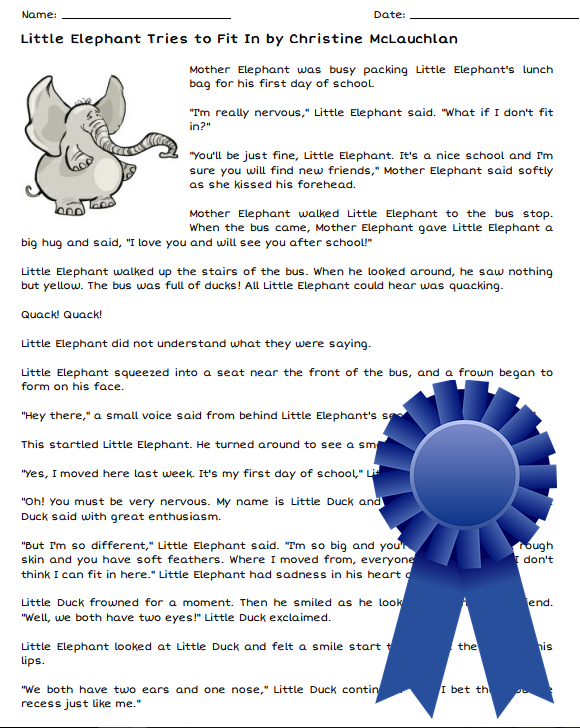Currently Browsing
Announcements
Announcing the 2021 HelpTeaching.com Scholarship Finalists
- 22 July //
- Posted in Announcements //
- Tags : scholarship
- Comments Off on Announcing the 2021 HelpTeaching.com Scholarship Finalists
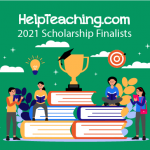
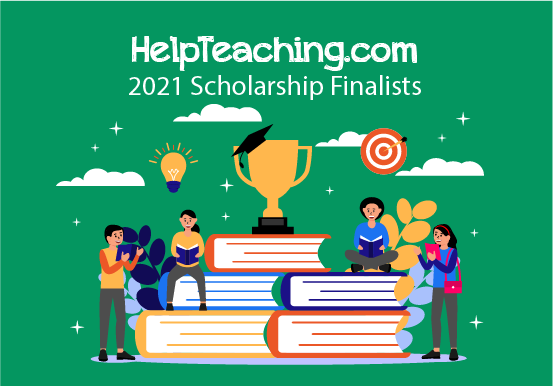
It’s that time of year again, where HelpTeaching.com holds its annual scholarship competition for aspiring writers! We put out a call for high school and college students to submit their short stories and informational texts aimed at children. The prize? A $1,000 prize to be paid to their learning institution.
We received around 1,000 submissions this year, and it was a tough job narrowing them down to our favorites! They were truly high calibre, interesting, creative, and fun to read. Some included themes of diversity and acceptance, others explained topics from how the stegosaurus was discovered to clever ways astronauts have used velcro! With each round of narrowing down our finalists, the task got even harder to choose the final winner. So, what we’ve done is compile a list of our top contenders and the piece we declared the winner.
Congratulations to all of the finalists and the 2021 HelpTeaching.com Scholarship winner!

10 The Day the Sidewalk Quacked
The title of this story immediately piqued our interest to read more. A sweet story of community-building, problem-solving, and teamwork Boise State University Junior, Ashlee Vanliew, tells the story of a duckling in need and getting it back to its mother. You can read the story here.
9 An Earful on the Human Hearing System
How much do you think you know about how humans hear? Grad student Marisa Kolanovic writes an informative article that details the workings of hearing. The complex system is described clearly and in an accessible way, bringing new appreciation to a sense many of us take for granted. Read the article here.
8 Meet the Stegosaurus
Dinosaurs are an area of fascination for many children, and kids surprise parents and teachers alike at pronouncing their names and reciting their attributes! We enjoyed this story about the discovery and description of the Stegosaurus, by seventeen-year-old Eva Ternovska. It’s a piece your students will love reading. Read the piece >>

7 The New Girl Victoria / La Niña Nueve, Victoria
Teaching students about diversity and inclusion is more important than ever, and we loved this story where language barriers are overcome creatively and friendships are forged with the help of technology. Read University Junior, Yanely Itzel Bolanos’, story here.
6 What is Kabuki?
Written by high school senior Hannah Cargo, this informational article explores Japanese Kabuki theatre. It’s wonderfully descriptive and educational about a style of theatre and acting that may seem quite foreign to those more used to method acting we commonly see on TV and in movies. Read Hannah’s piece here.
5 The Science of Accidents
This informational piece by University of Arizona Freshman, Kathlyn Wise is full of interesting stories about the origins of significant scientific discoveries, useful everyday objects, and life-saving medicine. Kathlyn is an incoming freshman at Wheaton College. Read the piece >>
4 The Lifecycle of a Star
Seventeen-year-old Jaden Klein deftly sums up the science of a star, clearly explaining the chemistry and physics behind the billions of twinkling stars in our galaxy. Read the piece >>

3 The Fainting Jar
Collecting is a past-time that many of us enjoy, and this delightful story by 16-year-old Avery Rose Nowowiejski caught our attention for its uniqueness, well-crafted story-telling, literary references, and pure charm. Click here to learn about Amy’s collection of faints in The Fainting Jar.
2 To Unbake a Cake
“Mom?” Aidan poked his head into the kitchen, a book tucked under his arm. “How would you unbake a cake?” We really enjoyed this novel approach to explaining chemistry concepts for reactions and states of matter by university sophomore Karen Zhang. It was well written, interesting to read, and clearly explained the science. Well done, Karen! Read the full story here.
THE WINNER!

1 The Origin of Money
Money is something we use everyday and it makes the modern world turn. But have you ever thought about how the system evolved? We loved how well written and explained this piece by 10th grader Crystal Ojiako was. Click to discover the Origin of Money.
Announcing the 2020 HelpTeaching.com Scholarship Finalists
- 6 July //
- Posted in Announcements //
- Tags : scholarship
- Comments Off on Announcing the 2020 HelpTeaching.com Scholarship Finalists


Every year, Help Teaching holds a scholarship competition for aspiring writers. High school and college students submit their best short stories and informational texts for kids in the hopes of winning a $1,000 prize.
This year, our team read through nearly 800 scholarship entries, many of which were amazing works. This year, instead of choosing ten finalists and a few honorable mentions, we narrowed the pool down to 15 pieces. The following entries rose to the top and one was ultimately declared the winner.
Congratulations to all of the finalists and the 2020 HelpTeaching.com Scholarship winner.
#15 Fighting a Cupcake Intruder by Jeana Schafer
Jeana Schafer’s piece takes kids through the digestive process by describing what happens to a cupcake from the moment it begins to enter the mouth. Through this piece, kids can learn more about what happens to the food they eat. Jeana is a 2020 graduate who plans to attend UC-Davis.
#14 Mae Jemison: Female Astronaut by Maya Sousa
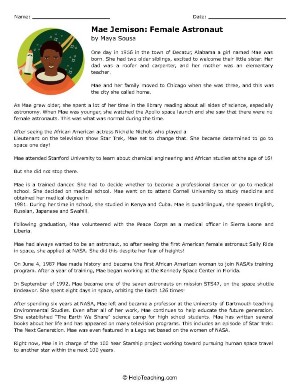
Mae Jemison was the first African-American astronaut. This piece by Maya Sousa, a student at the University of Colorado – Denver, describes her life and her impact on the space community.
#13 A Message from Mr. Rogers by Justin Hui
Mr. Rogers was known for his kindness and willingness to have difficult conversations in a way that kids could understand. This piece by Justin Hui, a recent graduate who plans to attend the University of Pittsburgh, shares a bit about how Mr. Rogers got his message across.
#12 Choose Your Own Adventure: The Life of a Plastic Water Bottle by Jennifer Xu
Jennifer Xu, a member of the Carlmont High School Class of 2021, wrote a piece that shows kids the importance of recycling. As they read, kids can pick what they want to do with a plastic water bottle and find out what happens as a result of the choice they make.
#11 Modern Treasure Hunt by Drew Cribbs
Have you ever been geocaching? Drew Cribbs, a graduate of Morgan County High School who plans to attend the University of Georgia, introduces kids to a way to enjoy a modern treasure hunt. The piece offers an overview of geocaching to help interest kids in the activity.
#10 The Mysterious Unicorn by Katelyn Shultz
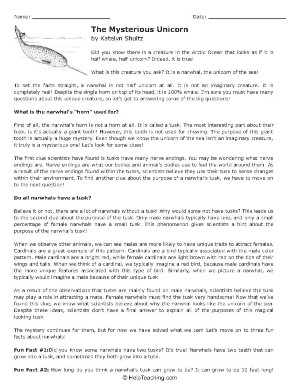
Narwhals are often thought of as mythical creatures, but they’re actually real. In her informational piece, Katelyn Shultz, a student at UNCW’s Watson College of Education, shares some fun facts about this unique creature.
#9 The Adventures of Ottie-O by Julie McCullough
Julie McCullough, a student at WGU, put her special education knowledge to work and wrote a story about an otter who struggles with loud noises. This is a great story to help students with autism or other sensory issues and can also be shared with other kids to help them understand their peers.
#8 The Lucky Color by Yen Nhi Ha
Red can symbolize many things, but in Asian cultures it is often a symbol of prosperity and good fortune. Yen Nhi Ha, a student at Jersey Village High School, shares the importance of this color in this short informational piece.
#7 A Special Leg by Arianna Turchetti
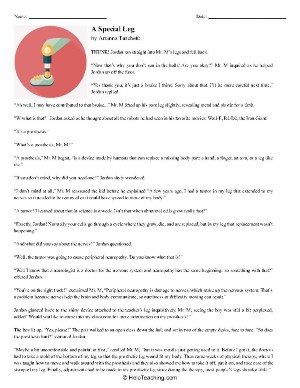
In this short story by Arianna Turchetti, a boy and his teacher have a very open conversation about what a prosthesis is. This story is a great way to introduce students to a topic that may be uncomfortable or unfamiliar to them. Arianna is a graduate of Enochs High School and plans to attend the Georgia Institute of Technology.
#6 A Round of Applause for the Costume Shop by Mariah Bowers
Mariah Bowers, a student at the University of Phoenix, takes students behind the scenes of the theater and introduces them to the costume shop. This short piece highlights some of the key positions in the costume shop, from the designer to the stitchers.
#5 Ruth Wakefield: History’s Smartest Cookie by Lena McEachern
Lena McEachern, a student at Carlsbad High School, shared the story of Ruth Wakefield, owner of the Toll House Inn and inventor of the infamous chocolate chip. Her story shows that sometimes not having the right ingredients on hand can lead to sweet surprises.
#4 Scared Speechless? by Keely Bayley
Many students struggle with public speaking, but Keely Bayley, a student at Fishers High School, gives them hope. This piece shares tips to help improve public speaking skills, beginning with the most important thing to remember when giving a speech: be prepared.
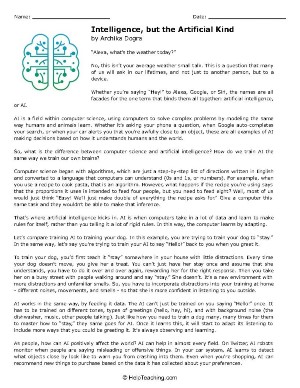
#3 Intelligence, but the Artificial Kind by Archika Dogra
How many people use voice recognition devices on a daily basis? This piece by Archika Dogra shares some information about these devices and explains how they differ from more conventional forms of computer science. Archika plans to attend Princeton University.
#2 A Job to Cuddle For by Katrina Chiong
One of our favorite pieces came in just before the deadline. Katrina Chiong, a student at Northside College Prepatory High School shared an informative piece about baby cuddlers. The piece explains the important role this hospital volunteers play in the lives of preemies.
#1 WINNER! Bessie’s Dream by Joanna Chong Jiaxuan
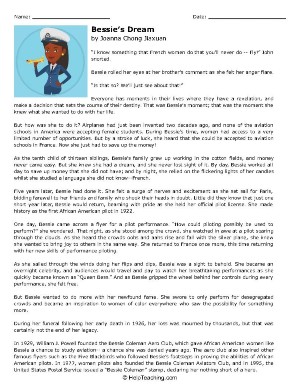
Bessie Coleman was one of the first African-American and female pilots in the world. This winning story from Joanna Chong Jiaxuan, a student at San Jose State University, describes how Bessie worked hard to reach her dream and the impact she had on the world.
If you know a high school or college student, encourage them to apply for the HelpTeaching.com scholarship next year. Entries are due June 1, 2021.
Don’t forget to read the stories from our previous finalists and winners: 2017, 2018, and 2019.
Announcing Test Room – Online Assessment Platform
- 25 May //
- Posted in Announcements, How To //
- Tags : online testing
- Comments Off on Announcing Test Room – Online Assessment Platform

Help Teaching offers Test Room, an online assessment platform designed for teachers, parents, tutors, and trainers. Test Room gives educators the power to administer assessments online. It also provides statistical data to help educators quickly monitor and assess student and class performance. As an educator, you have many reasons to quiz students and now Test Room provides the convenience, tools, and flexibility to do so in a meaningful way.
Creating Student Groups
The My Classes feature lets you organize and assign tests for individual classes or groups of students. Once you create a class, you can assign a test to the entire group at one time. You may add or remove students to classes at any point. In addition, once a class has finished a test, you will have access to statistics on overall test results enabling you to evaluate class performance. A few other options for the class feature include:
- Splitting up students in the same class into different classes in Test Room, perhaps by level
- Administering different versions of the test to different groups
- Creating and administering different tests to groups of students based on their ability levels or to easily adapt tests for special needs students
Scheduling Tests
Whether you want to give a brief quiz to check for understanding or a cumulative course final, Test Room offers numerous features for test scheduling to fit your needs.
Required Settings
Scheduling a test begins with either creating a custom assessment with Test Maker or selecting a pre-made assessment from Help Teaching’s expansive library of printable worksheets. After selecting a test to administer, simply choose your preferred method of inviting students to take the test. Options include:
- Inviting students or classes by e-mail which automatically sends students a direct link to start the test
- Sharing a public link with students instead of e-mailing them
Optional Features
In addition to the required settings, you can select a few optional features:
- Private Note to include any personal reminders or comments that are not shared with your students
- Test Instructions to share special instructions or reminders with your students when they start the test
Time Settings
Initially, all Test Room assessments offer unlimited testing times and open-ended start and end dates. As a teacher you can:
- Set a maximum amount of time students have to complete the test by filling-in the Time Allotted field
- Fill in the Start and End Date & Time fields to have students take or complete a test at a specific time
When you set these time settings your test will only be active during the set time period and can no longer be taken once the time period expires. Be sure to double check all your settings to make sure students can take your test when it’s time for them to start.
Test Administration Options
Depending on the purpose of assessment, you can select different options to change how students interact with the test. Some of these options include:
- Allowing students to navigate back to previous questions
- Keeping students from revising previous answers
- Enabling practice mode so students can see answers and, if desired, take the test multiple times
All of these features are available in the Test Administration section and you’ll find specific boxes and instructions to help you make those choices there . For example, if you want students to be able to navigate back to previous questions to revise their answers, be sure to check the correct box.
Want to embed a test into your website? Simply place the share link in an iframe, like the following:
“<iframe frameborder=”0″ height=”800″ src=”https://online.testroom.com/136832RVY” style=”width:100%”></iframe>”
Grading Tests
Along with giving students an easy way to take an exam, Test Room offers a few different options for grading, including:
- Automatic grading of multiple choice and true/false questions
- Immediate grade displays for students
- Fill-in-the-blank and open-ended questions you can grade by hand
- The ability to override any automatic corrections
With the grading feature, you can save a lot of time by letting Test Room do the grading and give students the feedback they want. Even if you choose to manually grade your assessments, you’ll still save time by allowing students to quickly take the test online.
Reviewing Analytics
To help provide you with a meaningful analysis of student mastery and progress, Test Room generates data on individual student performance and overall test performance.
Student Performance
Student performance data helps you see student performance based on the following information:
- an itemized list of each test that student has been assigned
- the completion status of the tests
- the grade for each test
- the date the test was scheduled
This way you can evaluate trends in individual student progress and test performance.
Overall Test Performance
Test Room also generates an overall statistical report for each test assigned. The test performance report provides:
- the total number of students who have completed the test
- the number of questions on the test
- the average number of correctly answered questions
- a grade breakdown by number of students
- percentage of correct answers for each individual question
With this data you can monitor how individual students are performing and help make sure the quizzes and tests you assign are producing the desired outcome.
For more information on how to use Test Room, watch this our tutorial:
Announcing the 2019 HelpTeaching.com Scholarship Finalists
- 20 June //
- Posted in Announcements //
- Tags : reading, scholarship
- Comments Off on Announcing the 2019 HelpTeaching.com Scholarship Finalists

This year, the HelpTeaching.com Scholarship received hundreds of entries. Students from all over the United States and Canada submitted stories, poems, and informational articles on topics such as understanding disabilities, making new friends, and taking care of the environment. After reviewing all of the entries, we have this year’s finalists and the winner of this year’s college scholarship. All of the finalists’ entries have been published on HelpTeaching.com and the winner will receive $1,000 to apply towards college tuition expenses.
Honorable Mention
Although these pieces didn’t quite make the cut, we felt they were still worthy of recognition.
Jessica Shenning, a freshman at Georgia State University, shared a short story about a little girl who enjoys baking with her mother and learns how to bake a special treat of her own. Read Learning to Bake >>
Jamie Lee, a student at the University of Virginia, wrote a story that reminds kids “there’s no place like home.” Read There’s No Place Like Home >> 
Lydia Colon, a senior at New Smyrna Beach High School, wrote about finding sand dollars in the ocean. Read Sand Dollars >>
Elise Carlson, a doctoral student at the University of Central Florida, focused on a slightly more taboo topic – toilets. Her piece helps kids learn how a toilet works. Read How a Toilet Works >>
Finalists
#10 The Science of Slime
If you’ve ever wondered how slime is made or the chemistry behind it, Jasmine Ma, a student at Middle College High School @ San Joaquin Delta College, has the answer. Her piece The Science of Slime helps kids learn more about the sticky substance.
Read more >>
#9 Between Sand and Sea
Dianne Mercado’s informational piece about the intertidal zone helps students learn about the different seasons found there. Dianne is a student at the University of Central Florida.
Learn more about the intertidal zone >>
#8 The Wood that Sings
Have you ever wanted to play the marimba? High school senior Molly Goins shares valuable information about the beautiful percussion instrument in her short piece.
Discover what it is>>
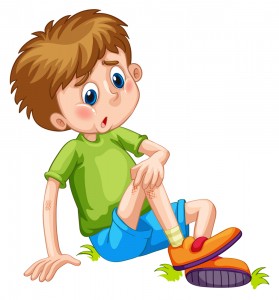
#7 What Happens When You Get a Scrape?
When you get a cut or a scrape, your body goes through a special process to help it heal. Amber Katharine Voightschild, a high school sophomore and homeschool student, describes the process in her informational text.
Find out how your body responds >>
#6 The Appalachian Creation
Graduate student Jenn Sisko wrote an informational article about the rocks that make up the Appalachian Mountain chain. Jenn attends Hamline University.
Discover how the mountain range formed >>
#5 Our First Thanksgiving
Lauren Collins, a recent high school graduate, and soon-to-be freshman at William Woods University wrote a piece about the first Thanksgiving from the perspective of one of the attendees, a native American girl.
Read more about the event >>
#4 Farmer Flynn and His Barnyard Companions
Farmer Flynn and his barnyard friends help kids learn more about where their food comes from and share tips for healthy eating in a short piece by Haein Kim, sophomore at Duke University.
Find out how what you eat makes your body healthier >>
#3 Uffo Goes to the North Pole 
As the polar ice cap begins to melt, the life of a polar bear becomes more difficult. Juan Restrepo, a student at Lees-McRae College, wrote a short story about a young polar bear named Uffo and his struggle to survive.
Learn more about Uffo and his mother >>
#2 Understanding the Human Heart
How much do you know about the human heart? Courtney Varela, a student at Swansboro High School, knows a lot and she put her knowledge into a creative short story for kids. After reading the story, kids will be able to know more about their own hearts too.
Discover more about the human heart >>
Winner

#1 How Do You Solve a Problem Like Maria?
Although the title sounds like a song from The Sound of Music, this short informational piece by Lucy Henneker actually shares information about a famous mathematician, Maria Gaetana Agnesi. Lucy is an incoming freshman at Wheaton College.
Read the winning piece >>
Watch for more details about the 2010 HelpTeaching.com Scholarship and start preparing your stories now! Don’t forget to check out 2017’s winner and finalists and the winning pieces from 2018 too.
Announcing the 2018 HelpTeaching.com Scholarship Finalists
- 13 July //
- Posted in Announcements //
- Tags : scholarship
- Comments Off on Announcing the 2018 HelpTeaching.com Scholarship Finalists
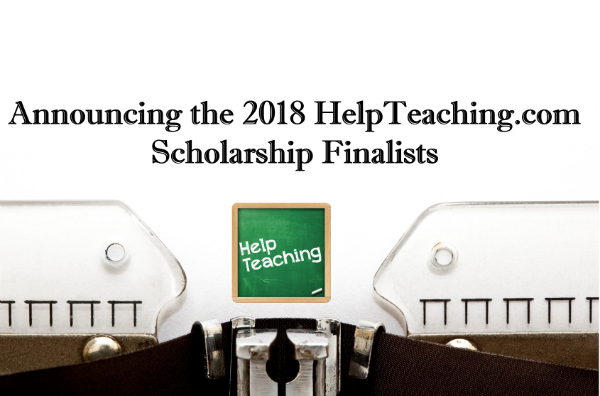 This year, the HelpTeaching.com Scholarship received over 600 entries, with students from all over the United States and Canada submitting stories, poems, and informational articles on topics such as being kind to others, learning about the human digestion system, understanding people with disabilities. We would like to commend all of our applicants for a job well done. After reading all of the entries, we have chosen the finalists and winner of this year’s scholarship. All of the finalists’ pieces will be published on HelpTeaching.com and the winner will receive a $1,000 college scholarship.
This year, the HelpTeaching.com Scholarship received over 600 entries, with students from all over the United States and Canada submitting stories, poems, and informational articles on topics such as being kind to others, learning about the human digestion system, understanding people with disabilities. We would like to commend all of our applicants for a job well done. After reading all of the entries, we have chosen the finalists and winner of this year’s scholarship. All of the finalists’ pieces will be published on HelpTeaching.com and the winner will receive a $1,000 college scholarship.
Honorable Mention
The following pieces weren’t named as finalists or the ultimate winner, but we felt they deserved recognition because they had something special to offer.
Megan Rice, a student from Lyman Memorial High School, penned a creative poem about the kingdom of Aspenkranze and a little girl that brought some happiness back to the king through dance.
Jon Kramer, a graduate of North Olmstead High School and incoming freshman at the University of Findlay submitted an intriguing piece about blinking.
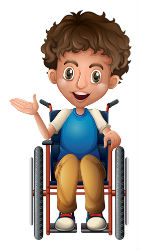 In addition to the pieces above, some authors chose to focus on bringing attention and fostering understanding when it comes to interacting with children with special needs.
In addition to the pieces above, some authors chose to focus on bringing attention and fostering understanding when it comes to interacting with children with special needs.
Piglet Max by Maddie Whittemore, an IB student from Southeast High school, tells the story of a little pig with autism.
My Friend Nicky by Olivia Placzek, a graduate of the Academy for Classical Education in Macon, Georgia, shares one child’s thoughts about a friend who has autism.
Victor’s New Friend by Nikki Foy, a student at ECU, tells the story of a kid who makes friends with a classmate who has spina bifida.
Finalists
#10 Mr. Owl and the Pelican Express
Jacob Grube, a high school senior, submitted a poem about an owl who aspires to make deliveries. The only problem? It’s a job that is typically performed by pelicans. Read more…
#9 Shy Sarah
Daniella Jenkins wrote a short story about a girl who goes from being shy to being self-assured. Her piece, particularly the poem at the end, can inspire kids to have confidence in themselves. Daniella is a student at Loyola University in New Orleans. Read more about Shy Sarah.
#8 Why I Don’t Look Like Mommy
In a short story by Lexus Hendrix, a student at the University of Central Florida, a little girl shares her feelings about her looks and the comments others make because she does not look like her mother. Even though they don’t look alike, she and her mommy do have something in common. Discover what it is!
#7 Being a Digital Citizen
In Natasha Moe’s short story, the main character learns an important lesson about being wise when posting on social media. It’s a great story to share with pre-teens or teens. Natasha is a graduate of Bloomington Senior High and an incoming freshman at Purdue University. Learn some tips for being kind online.

#6 Something to Chew On
Students are introduced to the process of digestion through a poem written by Kendall Lowe, a rising high school senior. Digestion isn’t pretty, but it is a pretty interesting process. Find out what happens!
#5 The Perks of Winter Days
Noah Snitzer’s submission featured a fictional account of dog sledding during a Canadian winter. The main character starts off reluctant to participate, but discovers a new appreciation for the work of his father. Read more.
#4 A Win for Nana
An apple pie is the basis for the short story written by Kennedy Webb, a student at the Ohio University Zanesville campus. Will Jamie’s pie in honor her nana take top prize at the county fair? Read the story to find out!
#3 A Big Difference
Grad student Ashley Teztlaff submitted a short story about a girl who raised money to build a well for children who did not have access to clean water. Ashley’s story highlights the ability kids have to make a difference. Learn more about it.
#2 You Are Unique
Kyle Mason, a student at The University of Tennessee, wrote a piece designed to help students learn more about their DNA makeup. After reading his piece, students will know that they truly are unique. Kyle even wrote his own questions to accompany the piece! Discover how unique you are!
Winner

#1 A Night in the Life of a Desert Tarantula
This year’s winner is Tatiana Rusev, a junior at Arizona State University. Perhaps inspired by the Arizona Desert Tarantula, Tatiana wrote a creative and informative piece entitled A Night in the Life of a Desert Tarantula. Through her story, kids can learn more about the arachnid that is commonly found in the Arizona desert. Find out more.
Watch for more details about the 2019 HelpTeaching.com Scholarship and start preparing your stories now! Don’t forget to check out 2017’s winner and finalists too.
Help Teaching’s Plan for GDPR Compliance
- 24 March //
- Posted in Announcements //
- Tags : GDPR, privacy policy, terms of service
- Comments Off on Help Teaching’s Plan for GDPR Compliance
On May 25th 2018, the most comprehensive change to privacy legislation ever undertaken —the EU General Data Protection Regulation (GDPR)— takes effect.
Here at Help Teaching, data protection is something we take very seriously. As a cloud-based company entrusted with our customers’ data, we’ll continue to view the treatment of our users’ data as a top priority.
Help Teaching and GDPR
Continuing to protect our customers’ information is extremely important to us. Measures we are taking include:
- Continuing to invest in our security infrastructure.
- Giving users the ability to access their own data and delete their account.
- Ensuring there’s a consent checkbox and that all user data is gathered only after receiving appropriate consent.
- Anonymizing IP addresses for Google Analytics
- For customers located in the EU: Implementing on a more robust Cookie Policy to make sure that merchants have the information they need to get effective consent for us to place the cookies necessary to provide our platform.
- Working to ensure we have the appropriate contractual terms in place with all relevant third parties.
- Updating our Terms of Service and Privacy Policy.
For more information on the specifics of GDPR, please read the regulation or this summary.
Announcing the 2017 HelpTeaching.com Scholarship Finalists and Winner
- 13 July //
- Posted in Announcements //
- Tags : announcement, free resources, scholarship
- Comments Off on Announcing the 2017 HelpTeaching.com Scholarship Finalists and Winner
 This year, HelpTeaching.com offered its first scholarship opportunity to students around the United States. Aspiring writers in high school and college were invited to submit an informational article or short story for kids. After reviewing hundreds of entries, the field was narrowed down to ten finalists. The pieces submitted by the finalists deal with topics ranging from fitting in and learning life lessons to understanding where money comes from. Read on to discover more about the finalists.
This year, HelpTeaching.com offered its first scholarship opportunity to students around the United States. Aspiring writers in high school and college were invited to submit an informational article or short story for kids. After reviewing hundreds of entries, the field was narrowed down to ten finalists. The pieces submitted by the finalists deal with topics ranging from fitting in and learning life lessons to understanding where money comes from. Read on to discover more about the finalists.
#10: You Are What You Eat by Emma Granger
This poem, written by Emma Granger, a student at the University of Manitoba, introduces kids to the important components of food and how they work in their bodies. Kids will learn the difference between fats, lipids, proteins, among others and discover why they truly are what they eat. We chose this poem as a finalist because it offers a unique and engaging format and also contains a lot of information for kids. Read the Full Story»
 #9: A Trip to Planet Brain: Journey to the Lobes by Kendall Nicely
#9: A Trip to Planet Brain: Journey to the Lobes by Kendall Nicely
Kendall Nicely, who will be attending Sweet Briar College in the fall, introduces kids to the parts of the brain through her short informational article. Kids can learn about each of the four lobes of the brain and, through the questions, identify key characteristics of those lobes. We chose this piece as a finalist because the information is presented in a kid-friendly, easy-to-follow format. Read the Full Story»
#8: What Makes a Genius? by Natalie Boubion
Have you ever wondered what makes a genius? Natalie Boubion, a student at UC Davis, answers the question in her short, informational article. People like Leonardo Da Vinci and Albert Einstein are considered geniuses, but how did they earn that title. We chose this article as a finalist because it presents a thoughtful discussion related to an interesting question. Read the Full Story»
#7: Money Supply: Its Creation and Destruction by Kaitlynn Gov
Another UC Davis student, Kaitlynn Gov, helps kids understand Money Supply through her short informational article. Not only can kids learn where money comes from, but they can gain an understanding of the importance of the money supply. We chose this article as a finalist because, in addition to the helpful information, the article contains key vocabulary words related to the economy. Those words are written in bold throughout the article and included in a word bank at the end of the article. Read the Full Story»
#6: A Tiger’s Life by Shae Sager
Shae Sager, a junior at Montana State University – Bozeman, wrote a short story written from the point of view of a tiger at two key stages in its life. Kids can read about the playful tiger cub, and then see how the tiger has changed by the end of this life. We chose this story as a finalist because of its unique perspective and the fact that it can be used as a lesson in comparison and contrast. Read the Full Story»
#5: Rainy Dog Saturday by Erin Conlon
Erin Conlon is a student at the Minneapolis College of Art and Design, pursuing a Bachelor of Applied Science degree in Animation. Her story, Rainy Dog Saturday, tells the story of an eight-year-old boy who cannot find anything fun to do on a rainy day. However, when he hears a sound at the door, his day starts to become a little more interesting. We chose this story as a finalist because it is a cute story for kids that offers an element of surprise. Read the Full Story»
#4: The Great Flower Competition by Ella Commerce
Ella Commerce recently graduated from Mt. Carmel High School in San Diego, California, and will be attending California Polytechnic Institute in the Fall. Her short story, The Great Flower Competition, tells the story of two brothers whose father issues them a challenge. The boy who can present him with the most flowers at the end of a month will win the competition. We chose this story as a finalist because it helps kids learn an important lesson. Read the Full Story»
 #3: Why Wolves Howl at the Moon by Emily Edmonds
#3: Why Wolves Howl at the Moon by Emily Edmonds
Why Wolves Howl at the Moon is a short story by Emily Edmonds, a student a North Greenville University in Tigerville, South Carolina. In this story, Mama Wolf shares with her wolf cubs the story of why wolves howl at the moon. We chose this story as a finalist because it has the feel of a classic myth and tells a tale that many kids will find interesting. Read the Full Story»
#2: Little Lost Fish by Gina Gugliotta
Gina Gugliotta is a Health Sciences student at The Ohio State University. Her work as a swim instructor inspired her to write a poem to help children remember to stay safe around a pool. We chose this poem as a finalist because of its rhyme scheme and the creative way it teaches an important lesson to kids. Read the Full Story»
And the winner of the first HelpTeaching.com scholarship is…
#1 WINNER!: Little Elephant Tries to Fit In by Christine McLauchlan
Little Elephant Tries to Fit In, written by Christine McLauchlan, an Early Education major at New Brunswick Community College. tells the story of an elephant who has just moved to a new town and is facing his first day at a new school. We chose this story as the winner of the HelpTeaching.com scholarship competition because it deals with emotions that many kids can relate to and it helps kids understand that it’s okay to be different. Aside from the lessons the story teaches, we feel like Little Elephant Tries to Fit In is a cute story that will make a fun read-aloud in the classroom. Read the Full Story»
In addition to these passages from our scholarship finalists, check out the other informational stories and reading passages we have to offer.
Think you have a great story for the HelpTeaching.com scholarship contest or know students who like to participate? Help spread the word about this scholarship by posting the information and a link to our scholarship page on your school or organization’s website.
What’s New at HelpTeaching.com for Fall 2016
- 10 August //
- Posted in Announcements //
- Tags : lessons, new content, worksheets
- Comments Off on What’s New at HelpTeaching.com for Fall 2016

This summer, while you were on vacation, spending time with your kids, and prepping for the new school year, our content creators at HelpTeaching.com were busy creating exciting new resources in all of the major subject areas. Our new offerings range from NGSS-aligned reading passages for grades K-2 to self-paced math and science lessons for higher grades. Read on to discover some of the new features on our site.
English/Language Arts
Grade-Level Spelling Lists
We’ve added grade-level spelling lists from grades K-5. Each grade features 30 individual spelling lists with 10 words each (5 words each for kindergarten). The lists were compiled using Dolch sight words, Fry words, Tier II words, and Marzano’s subject-area words for each grade-level. Each list is accompanied by a word search and 1-2 additional worksheets.
Writing Prompts and Worksheets
Our writing page has been expanded to include writing prompts for all grade-levels through grades K-12. Prompts are organized by grade-level (grades K-2, 3-5, 6-8, and 9-12) and type of essay (opinion/persuasive, informative/explanatory, and narrative).
Also, on the writing page, you’ll find weekly writing worksheets for grades K-2 and grades 3-5. Each worksheet features 5 short writing prompts related to a common theme (for example, students may write about the town they live in) for the week. You can use these prompts as bell ringers, short journal prompts, or homework assignments to encourage students to write every day.
For something a little more fun, you can also check out our collection of “Would You Rather?” prompts for students. These prompts feature funny scenarios that encourage students spark discussion, inspire creative thinking, and give students something fun to write about about. Some questions include:
- Would you rather only eat pizza for the rest of your life or never eat pizza again?
- Would you rather wear socks without shoes or wear swim flippers everywhere?
- Would you rather use an old-fashioned phone or never talk on the phone again?
Prefix and Suffix Lessons
On our vocabulary page, you’ll find worksheets that cover the most-common prefixes and suffixes in the English language. You can also find short self-paced lessons related to each of the worksheets.
New Grammar Resources
If you’re looking for ways to help students boost their grammar skills, look no further than our daily grammar worksheets. These worksheets are designed to help students in upper-elementary and middle school learn to identify and correct common errors related to grammar, spelling, punctuation, and capitalization. Worksheets are labeled by passage topic. You’ll find worksheets about celebrities, historical events, sports, and other high-interest topics. For example, check out this daily grammar activity related to the former capital of the U.S.
We’ve also re-organized our grammar page by part of speech and skill to make it easier to find the content that you need. Worksheets are also organized by grade-level within each part of speech or skill.
NGSS-Aligned Reading Passages
Our ELA and science areas have come together to develop NGSS-aligned reading passages. This summer, we added a set of kindergarten reading passages and questions. Teachers can read these passages aloud in the classroom and ask students the questions or send them home with students to help reinforce NGSS content outside of the classroom. Keep watching our site throughout the fall and winter for NGSS passages for other grade-levels.
Coming Soon!
The work started on our ELA content this summer is far from over. Stay-tuned this fall and winter as we add:
- Research worksheets
- More daily grammar worksheets
- Phonics worksheets
- Self-paced writing lessons
- Worksheets related to popular books
Math
Self-Paced Math Lessons
We’ve grown our library of high school algebra lessons this summer! Each lesson includes a topic overview, Help Teaching original video lesson, and practice questions. Use these self-paced, online lessons with your classroom math curriculum or supplement your child’s math instruction at home. With Test Room, assigning lessons and tracking student progress couldn’t be easier! Get started with our new lessons on Solving for Variables or Polynomials 101.
Daily Math Practice Worksheets
Supplement your lower elementary curriculum and reinforce essential math skills with our new daily math practice worksheets. Each week features a two-page worksheet designed for front-to-back printing while providing space for student work. Use the four days of math problems for morning work or weeknight homework. Separate fifth day quizzes are included for optional progress monitoring. Worksheets are Common Core aligned and offer spiral review of previously covered standards. Try Week 1 for kindergarten or grade 1 and check our elementary math page frequently as more weeks are coming this fall!
Science
Self-Paced Science Lessons
New physics and chemistry video lessons are here! We have updated many of our high school science lessons with Help Teaching original videos and added entirely new lessons. Whether you are a teacher looking for high-quality content to supplement your science instruction or a high school student looking to learn more on a topic, our self-directed lessons can help. Check out our lessons on Kinetic Molecular Theory and Resistance and Ohm’s Law as a starting point, then visit our science lesson page for more!
NGSS-Aligned Content
The Next Generation Science Standards (NGSS) provide a progression of crosscutting concepts, practices, and core ideas for today’s science students. Here at Help Teaching, we have begun adding NGSS aligned content including lessons, worksheets, and assessment questions. If you are looking to supplement your science curriculum with NGSS aligned content, then check our lessons, including: Why Does the Sun Look So Bright?, Introduction to Biogeology, and Wave Speed. NGSS worksheets like Sorting Materials By Properties, Push and Pull Reading Passage, and Earth Event Timescales are noted with (NGSS) in their link names and standard alignment is provided. Search for NGSS questions to see all content available and to create your own custom assessments. Look for more new NGSS content at HelpTeaching.com during the upcoming school year!
Subscribe to the Help Teaching newsletter on our homepage to stay up-to-date with all new lessons, worksheets, articles, and features. Be sure to use our seasons worksheets for back-to-school and fall to help kickoff this new school year!
Test Designer is now Help Teaching
- 27 July //
- Posted in Announcements //
- Tags :
- Comments Off on Test Designer is now Help Teaching
We’re excited to announce that Test Designer is now Help Teaching!
Why We’re Changing our name to HelpTeaching.com
TestDesigner.com launched in 2005 as a test maker tool, with a little over 100 questions across a dozen subject areas. When we first launched, we faced a classic chicken-and-egg problem – the platform needed content to be successful but didn’t yet have users to add that content. Fast forward to 2011 – the site had over 50,000 public questions across more than 300 topics and over 100,000 users worldwide. With all of the questions we had, we thought it only made sense to create a library of free printables. To give back to the community, we added free printables in December 2011. Printables, of course, turned out to be hugely popular with our members. So in the last 18 months, we have added hundreds of new worksheets and activities to our site.
Due to our expanded offerings, the original site name no longer represented all we had to offer and didn’t connect with our primary audience. Test Designer now offers numerous resources for teachers, homeschoolers and educators of all types designed to help them with teaching, hence the new name – Help Teaching.
What’s Next?
Where to begin? With the Common Core State Standards, of course! We are working aggressively to align our existing content to the CCSS and adding new content across the ELA and Math standards. We have an ambitious goal to have all standards covered for the start of the 2013-2014 school year.
And we’re not stopping there! We thought, “Why not use our extensive library of images and add other resources besides worksheets?” As a result, we will be adding study guides, games and lesson plans in the coming months.
We would like to take this opportunity to say thank you. Thank you so, so much for helping us grow by providing your feedback and offering your support over the last 7 years. Test Designer was something special, and, with your continued help and support, Help Teaching will be something even more special. As always, you can find us on Facebook, Twitter, Google+, and Pinterest, or just send us an email to support at testdesigner.com
With hugs, love, and gratitude,
Lilia Tovbin
Founder, Tribrio Inc.
Announcing New Premium Worksheets
- 1 June //
- Posted in Announcements //
- Tags : common core
- Comments Off on Announcing New Premium Worksheets
The Common Core State Standards are one of the current hot topics in education. As schools across the country have begun to adopt the standards, teachers must find new ways to assess the critical and higher order thinking skills they measure. Test Designer’s members can now find ways to assess the Common Core State Standards directly through standards-aligned worksheets on HelpTeaching.com.
Worksheets aligned to the Common Core English standards can already be found on Test Designer. As soon as you open a Common Core aligned worksheet, a new module on the print preview page allows you to instantly see the standards the worksheet is aligned with.
One of the first subject areas of Test Designer to be aligned to the standards is language arts. Many of the worksheets you will find in the reading strategies category have been designed to include the in-depth analysis, reasoning and comparison and contrast skills that the standards promote. Students will also be introduced to longer reading passages and associated questions, similar to what they will find on many standardized exams. For example, eighth grade students can analyze President Roosevelt’s Pearl Harbor Address to the Nation in the Analyzing a Speech worksheet and fifth grade students can analyze characters in popular short stories. Common Core aligned worksheets are also available for grammar instruction. Instead of simply identifying the parts of speech, students can put them to use combining sentences and correcting punctuation. Many of the Common Core Standards for language are already represented through worksheets available on the Test Designer site.
English teachers are not the only ones who can access standards-aligned worksheets. Worksheets are also available for math for grades two through five on topics such as money word problems and for grades six to eight on topics such as the Pythagorean Theorem and Geometric Solids. While the Common Core Standards do not cover general science and social studies skills, teachers can also access premium worksheets in these areas. These premium worksheets, such as one Muscular System Anatomy, feature high-quality images and content.
Throughout the summer, Help Teaching team plans to add worksheets covering nearly all Common Core standards and content areas. However, access to these Common Core aligned worksheets and future worksheets is only available by subscribing to Help Teaching Pro.


